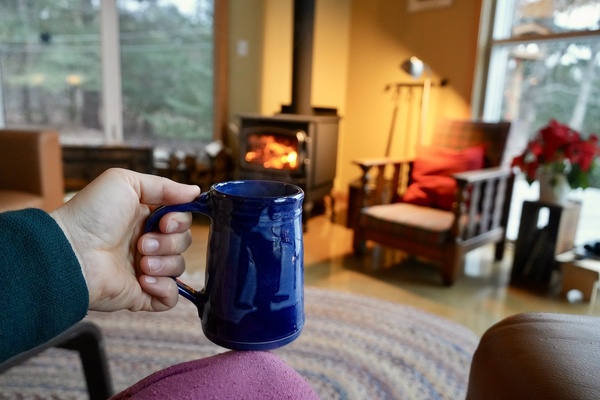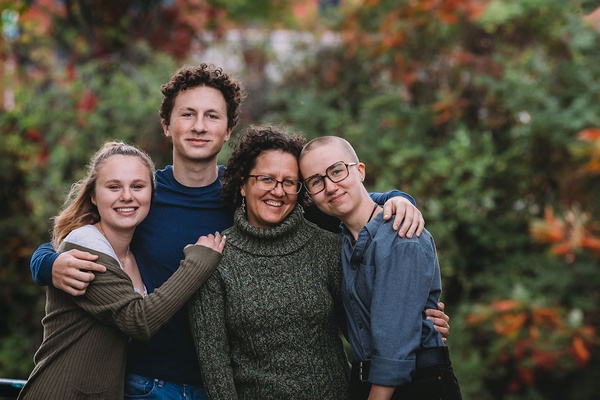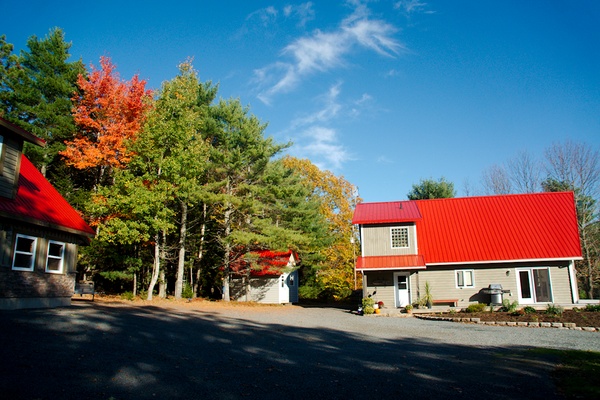Get posts by email
One Pot Wonders
January 12, 2012
This post was originally published in Heather Bruggeman's Whole Food Kitchen online workshop.
Our family has been eating a mostly plant based diet for eleven years. During that time our dietary focus has run the gamet from "is this vegan? to "where does it come from?"
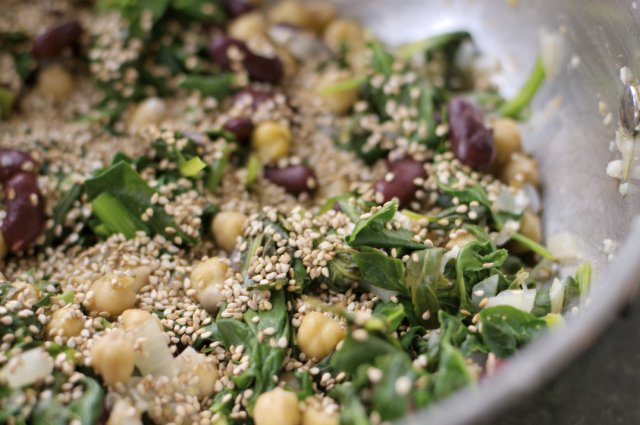
More recently, our focus is whole plant foods and overall nutrition. Trying to increase our consumption of really nutritious whole plant foods vs. plant-based foods in general. There's a lot of plant-based foods, potato chips (my personal weakness) for example, that at best have no nutrition. Or at worst, are an actual detriment to your health.
Diet, like everything else in life, is a journey and we've learned a lot in the last decade that has changed our understanding of nutrition and subsequent food choices.
One thing that has remained fairly fixed along this nutritional journey though is one pot meals.
A One Pot Story
We started our plant-based journey with lots of pasta and grain based one pot meals. Since then we have moved to more whole food, nutrient dense one pot meals. I give a few examples in the One Pot Ideas section below.
I can barely remember now what it was like to stop cooking meat and adding dairy products, in some form, to nearly every meal. But I do remember wondering how to fill the plate.
I was used to preparing fairly standard fare based around a meat dish. Chicken night, beef night, fish night, etc.. Then we filled the rest of the plate, quite literally, with a vegetable side, bread, rice or pasta. The meal's flavor and flair was mostly in how the meat was prepared or the sauce it was served in.
I was intellectually on-board for largely removing meat (we are not 100% vegan and do eat animal products occasionally) from our plates but practically I wasn't sure how to do this and still feel like we were eating a complete meal. The plate seemed kind of empty and bland.
It didn't have to be bland. I found cookbooks with lots of good recipes (this was over a decade ago, I don't even remember the titles) but they tended to be gourmet type cooking. And presented plates spread with three different dishes, each of which seemed like a meal unto itself.
I like cooking. I'm good at it too but I just didn't have time to cook gourmet vegan suppers on a regular basis with three little children under foot.
So I learned how to cook one pot meals, in essence making the side dish the main affair.
One pot meals started out of necessity in our home. The goal being to not spend all afternoon in the kitchen and to get a tasty, nutritious meal on the table for my growing family. It's now evolved to my modus operandi in the kitchen.
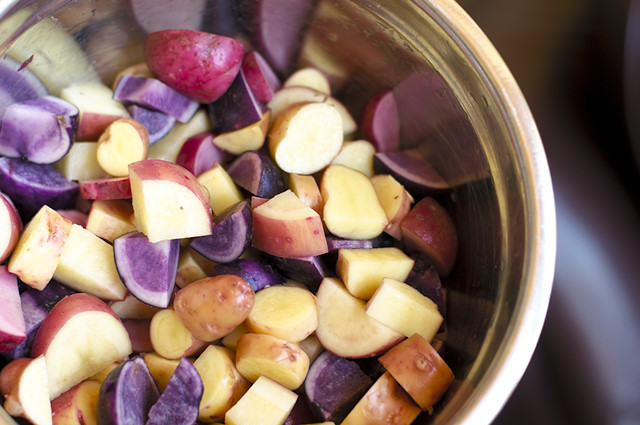
One Pot Ideas
Firstly, a definition of a one pot meal. It's fairly straightforward - you do all your cooking in one pot. However, I do bend the definition to include a starch (grain, potato, squash) cooked separately and served together with the one pot dish.
For example, we often eat curry or stirfry (two of our favorites recipes are included in this post) served over brown rice. Technically, that's two cooking pots but it's served together so I consider it a one pot meal.
We found that a large soup bowl was best for eating this kind of food and we stopped using plates for supper years ago. We use plates at lunch instead to eat our meal-sized salads.
I'm a plant-based cook, so these are all vegan ideas. You can add or substitute meat or dairy depending on your preference.
- Bean and vegetable sauces served over grains, potatoes (white or sweet) or winter squash.
- Soup, stew & chili. These are the mainstay of our winter diet. Minestrone, lentil, potato broccoli, or split pea soup. South American or Sweet Potato African stew. Bean and veggie chilis. There are so many possibilities.
- Stirfry or curry served with whole grains.
- Casseroles and baked dishes.
- Whole grain pasta topped with sauce.
- Pilafs and fried rice.
- Salad meals. These are a big part of our summer diet. Any grain, vegetable, and protein combination. Tabouleh, Asian Noodle Salad, quinoa and chick peas, brown rice and black bean. Experiment!
- Wraps or stuffed pitas. Not really "one pot" but eaten all together.
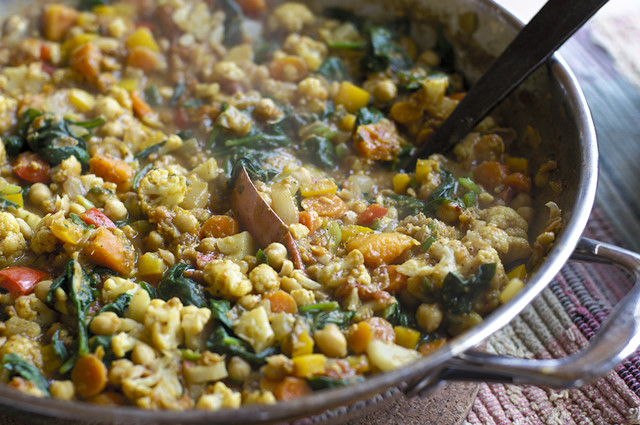
One Pot Love
Simplicity
Obviously, there's the whole one pot factor. Less clean up. But there is also simplicity of time.
Cooking one pot meals and having a few good kitchen tools allows me to spend less time in the kitchen than I would if I was preparing multiple things - a salad, a side, a vegan "main dish".
One of my favorite kitchen tools is my pressure cooker which makes one pot cooking speedy as well as easy. I'm a huge fan of my pressure cooker and highly recommend one (or two) for the whole foods kitchen.
To be perfectly clear, there is still lots of prep work for our meals - veggies to wash and chop, beans and grains to cook. But good tools make it easier. And bringing it all together in one pot makes it taste great. Which brings me to my next point.
Taste
Who wants to eat healthy food if it doesn't taste good? Granted, it takes a while for taste buds to change but whole, plant based foods can taste really good, even to people unused to that kind of food.
There once was a time, long, long ago... when vegetarian, whole food fare was brown rice topped with a squirt of soy sauce, served with steamed broccoli.
Nothing against really simple fare. But that sounds like an elimination diet (which we've done), not the kind of food my family wants to eat on a regular basis.
When we first changed our diet it seemed that if you removed a flavorful meat (the flavor coming mostly from the seasoning and fat) you were left with bland starches and veggies. I found that by cooking everything together in one pot with select spices and seasonings, or mixing a whole grain and bean salad up in one bowl, I could combine flavors and make otherwise bland floods - like brown rice - taste great.
One Pot Tips & Tricks
Depending on what you and your family (many of us cook or share meals with other people) are used to, preparing your food all together in one pot or mixing it up in one bowl might sound kind of strange. Even unappetizing.
If you want to include more one pot meals in your menu start with more familiar offerings like stirfry over rice.
Start eating a few more of these and experimenting with ingredients - different seasonal veggies and a couple different sauces. Schedule a stir fry night in your menu plan.
If you are meat-eaters, try different meats in your stirfry. Vegetarian? Try tofu, seitan or beans. In my experience, chickpeas are a good stirfry bean.
What I love about stirfies is how easy they are to pull together once the chopping is done. Ask for help with the chopping and you'll have a meal ready in under an hour.
Don't overcook the veggies. Just because it's served in one bowl doesn't mean it has to look like gruel.
Unless it's supposed to be pureed, like a soup, learn how to time cooking veggies so they retain their textures.
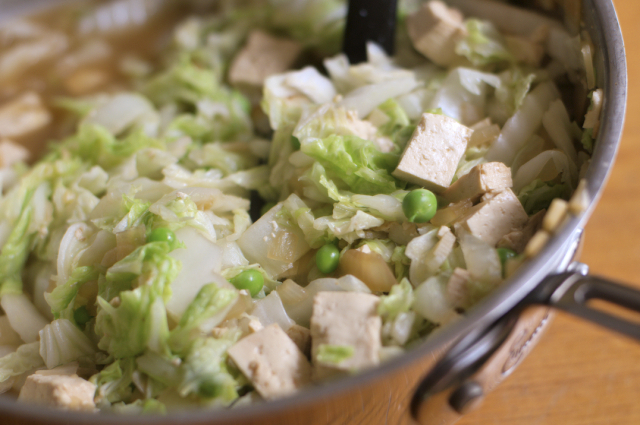
I've learned to not cook all the veggies at one time. So if I'm making a curry I start with sauteing onions and garlic, then add my curry powder till fragrant, then add my "hard" vegetables and some liquid. Cook that for a bit, then add your soft vegetables. That way each vegetable gets cooked to its best texture.
Part of people's aversion to cooked vegetables mixed with other foods, I believe, is that they are often over cooked.
Eat cooked vegetables at supper, and raw other times of day.
Some vegetables lend themselves well to being cooked with other foods. Use those for your one pot meals and eat raw veggies other times of day.
We eat a large salad most lunches. If this isn't possible because of school lunches, etc... serve raw veggies for an afternoon snack, prepare a salad to go along with supper but have the rest be a one pot dish.
I aim to include a cruciferous vegetable (broccoli, Brussels sprouts, cauliflower, bok choy, collards, kale - there is others, but these are the most common) at each supper. They are super healthy and cook well into one pot meals.
If a one pot supper meal once in a while doesn't have a green veggie at all (for example, one of my go-to easy recipes is baked potato topped with a tomato bean sauce) it's ok. Not every meal needs a perfect combination of veggie, starch/grain, and a protein (or whatever your food plan is).
I look at the quality of my family's diet over the course of the day and week. Not an individual meal. I'm no nutritionist, I leave that to people like Heather, so don't quote me on this, but a healthy diet is the whole picture, not a one meal snapshot.
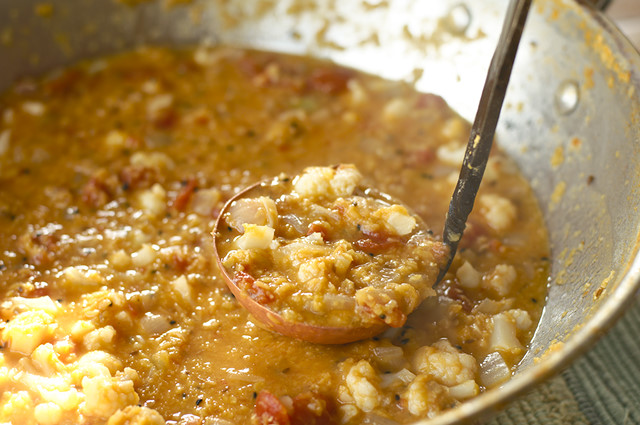
Attached to this post are two of my family's favorite one pot meals. A potato cauliflower curry and a cabbage stir-fry served over rice. Both of these meals are great for this time of year and feature vegetables readily available in any grocery store.
Click to view and download recipes→ potato cauliflower curry & cabbage stir-fry served over rice.
A little disclaimer about cooking and eating cabbage. My family loves cabbage and thinks nothing of sitting down to eat a pot of crunchy-cooked cabbage for supper. If your family is less than enthusiastic about this fabulous vegetable introduce it as a side dish first.
Filed Under
Part of Series
Resource Library
You can subscribe to comments on this article using this form.
If you have already commented on this article, you do not need to do this, as you were automatically subscribed.
